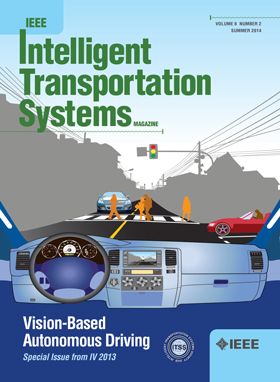Knowledge Distillation-Based Spatio-Temporal MLP Model for Real-Time Traffic Flow Prediction
IF 7.9
1区 工程技术
Q1 ENGINEERING, CIVIL
IEEE Transactions on Intelligent Transportation Systems
Pub Date : 2024-09-23
DOI:10.1109/TITS.2024.3424808
引用次数: 0
Abstract
Real-Time Traffic Flow Prediction (RT-TFP) is one of the critical technologies for implementing the Intelligent Transportation System (ITS), enabling rapid and accurate prediction of real-time traffic flow at intersections. RT-TFP typically needs to be deployed on-site edge devices for real-time traffic flow calculation that requires low inference latency and minimal computational resources. However, the existing Traffic Flow Prediction (TFP) models are generally based on spatiotemporal graph neural networks (STGNNs), which are complex and require high computational resources and relatively high inference times that can hardly be deployed on edge devices. To this end, this work proposes a simple RT-TFP model, SpatioTemporal-MultiLayer Perceptron (ST-MLP), which requires low computational resources and inference times. The base idea of this work is to establish a spatio-temporal MLP model to replace the STGNN model for conducting the TFP, which is much faster and simpler. Specifically, first, a TempEncoder is proposed to encode the temporal information into the MLP features. Then, a Spatiotemporal Mixer is proposed to mix spatial information into the temporal-enriched MLP features. After, MLP features are distilled from a complex STGNN model to obtain a simple MLP that inherits complete Spatial-Temporal information of the traffic graph. The experimental results on four real-world datasets show the proposed model achieves competitive prediction accuracy with STGNN models in much fewer computational resources and lower prediction time costs. It is worth noting that, the proposed method is faster than the compared STGNNs by an average of 21.62 times (~10.81s基于知识蒸馏的时空 MLP 模型用于实时交通流量预测
实时交通流量预测(RT-TFP)是实施智能交通系统(ITS)的关键技术之一,可快速、准确地预测交叉口的实时交通流量。RT-TFP 通常需要部署在现场边缘设备上,以进行实时交通流计算,这需要较低的推理延迟和最少的计算资源。然而,现有的交通流预测(TFP)模型一般都基于时空图神经网络(STGNN),其结构复杂、计算资源要求高、推理时间相对较长,很难部署在边缘设备上。为此,本研究提出了一种简单的 RT-TFP 模型--时空多层感知器(ST-MLP),它只需较少的计算资源和推理时间。这项工作的基本思想是建立一个时空多层感知器模型(spatio-temporal MLP),以取代 STGNN 模型,从而更快、更简单地进行 RT-TFP 计算。具体来说,首先提出了一个 TempEncoder,用于将时间信息编码到 MLP 特征中。然后,提出一个时空混合器,将空间信息混合到时间丰富的 MLP 特征中。之后,从复杂的 STGNN 模型中提炼出 MLP 特征,得到一个简单的 MLP,继承了交通图的完整时空信息。在四个真实世界数据集上的实验结果表明,所提出的模型以更少的计算资源和更低的预测时间成本,达到了与 STGNN 模型相当的预测精度。值得注意的是,所提出的方法比所比较的 STGNN 平均快 21.62 倍(~10.81s $\rightsquigarrow ~\sim 0.50$s)。有趣的是,与相应的 STGNN 模型相比,所提出的 ST-MLP 平均错误率甚至下降了 -3.23%。此外,所提出的 ST-MLP 的错误率比纯 MLP 降低了 -3.92% $\sim -42.62$ %。源代码见:https://github.com/zhangjunfeng1234/ST-MLP
本文章由计算机程序翻译,如有差异,请以英文原文为准。
求助全文
约1分钟内获得全文
求助全文
来源期刊

IEEE Transactions on Intelligent Transportation Systems
工程技术-工程:电子与电气
CiteScore
14.80
自引率
12.90%
发文量
1872
审稿时长
7.5 months
期刊介绍:
The theoretical, experimental and operational aspects of electrical and electronics engineering and information technologies as applied to Intelligent Transportation Systems (ITS). Intelligent Transportation Systems are defined as those systems utilizing synergistic technologies and systems engineering concepts to develop and improve transportation systems of all kinds. The scope of this interdisciplinary activity includes the promotion, consolidation and coordination of ITS technical activities among IEEE entities, and providing a focus for cooperative activities, both internally and externally.
 求助内容:
求助内容: 应助结果提醒方式:
应助结果提醒方式:


